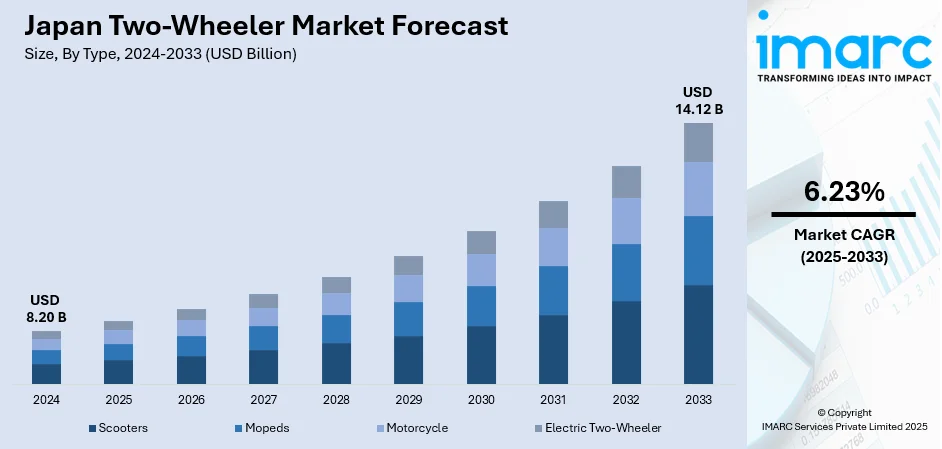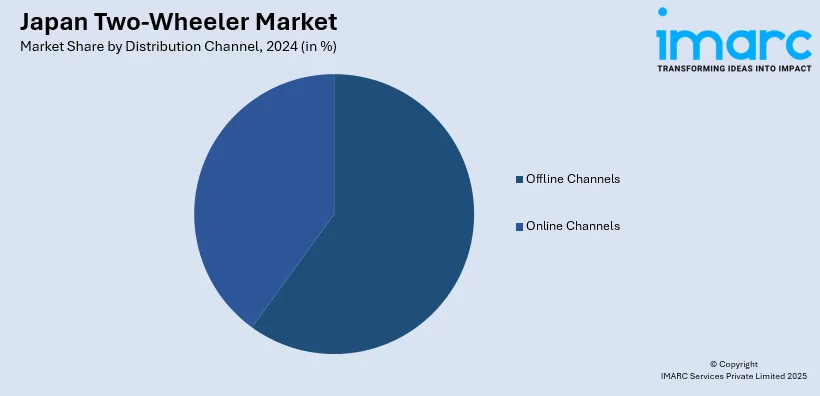
Japan Two-Wheeler Market Size, Share, Trends and Forecast by Type, Technology, Transmission, Engine Capacity, Fuel Type, Distribution Channel, End User, and Region, 2025-2033
Japan Two-Wheeler Market Overview:
The Japan two-wheeler market size reached USD 8.20 Billion in 2024. Looking forward, IMARC Group expects the market to reach USD 14.12 Billion by 2033, exhibiting a growth rate (CAGR) of 6.23% during 2025-2033. Urban congestion, last-mile connectivity needs, and Japan’s regulatory push for low-emission transport are driving the two-wheeler market, as individuals and manufacturers increasingly shift toward compact, agile, and eco-friendly mobility solutions aligned with national sustainability goals and evolving urban infrastructure.
|
Report Attribute
|
Key Statistics
|
|---|---|
|
Base Year
|
2024 |
|
Forecast Years
|
2025-2033
|
|
Historical Years
|
2019-2024
|
| Market Size in 2024 | USD 8.20 Billion |
| Market Forecast in 2033 | USD 14.12 Billion |
| Market Growth Rate 2025-2033 | 6.23% |
Japan Two-Wheeler Market Trends:
Urban Congestion and Last-Mile Mobility Needs
Urban congestion and a restricted space in Japan's closely packed cities are making two-wheelers an essential means of transport for short journeys. Their small dimensions and agility enable riders to avoid traffic and navigate narrow streets that are typically unsuitable for cars. As urban planning prioritizes space efficiency and areas for pedestrians, two-wheelers seamlessly integrate into the flow of city life. Their affordable operating expenses and convenient parking enhance their attractiveness, particularly in older urban neighborhoods where infrastructure is unable to support larger vehicles. With an increase in public transport usage, the demand for dependable last-mile connectivity rises as well, and scooters are filling that gap. In line with this trend, in 2024, Honda and Yamaha enhanced their collaboration as Honda consented to provide Yamaha with electric scooters derived from its EM1 e: and Benly e: models. These Class-1 electric two-wheelers featured swappable batteries, making them perfect for brief city travels and commercial delivery uses. This partnership illustrates how producers are addressing urban needs by providing adaptable, eco-friendly, and space-saving transportation solutions. These advancements also correspond with local and national initiatives aimed at decreasing vehicle emissions, indicating a future in which compact electric two-wheelers are integral to Japan’s urban mobility system.

Growing Commitment to Sustainable Mobility
Japan's robust regulatory framework and policy-focused dedication to sustainability are influencing the evolution of its transportation industry, encompassing the two-wheeler sector. As national goals emphasize cutting greenhouse gas emissions and moving away from fossil fuels, manufacturers face significant pressure to create cleaner alternatives. This movement is supported by government-backed programs that encourage zero-emission vehicles, financial support for green technology research, and the gradual enhancement of environmental regulations. As a result, both established and new companies are increasing their initiatives to create low-emission or zero-emission two-wheelers, such as those fueled by electricity, hydrogen, and other alternative energy sources. The growing concerns about urban air quality and Japan's sensitivity to changes in fuel prices are driving the need to lessen dependence on conventional internal combustion engines. This significant transition towards clean mobility encompasses not only passenger vehicles but also significantly impacts the two-wheeler sector, which is essential for urban transportation and logistics. The market is reacting with high-performance models that adhere to sustainability standards while ensuring user convenience, framing green mobility as not merely a compliance obligation but as a competitive advantage. In 2025, Kawasaki unveiled a hydrogen-powered motorcycle prototype, the Ninja H2, developed in collaboration with Honda, Yamaha, and Suzuki. The bike features a 998cc supercharged inline-four engine running on hydrogen fuel, emitting only water as a byproduct. It represents Japan's push toward sustainable mobility, with public availability expected in the 2030s.
Japan Two-Wheeler Market Segmentation:
IMARC Group provides an analysis of the key trends in each segment of the market, along with forecasts at the regional level for 2025-2033. Our report has categorized the market based on type, technology, transmission, engine capacity, fuel type, distribution channel, and end user.
Type Insights:
- Scooters
- Mopeds
- Motorcycle
- Electric Two-Wheeler
The report has provided a detailed breakup and analysis of the market based on the type. This includes scooters, mopeds, motorcycle, and electric two-wheeler.
Technology Insights:
- ICE
- Electric
A detailed breakup and analysis of the market based on the technology have also been provided in the report. This includes ICE and electric.
Transmission Insights:
- Manual
- Automatic
The report has provided a detailed breakup and analysis of the market based on the transmission. This includes manual and automatic.
Engine Capacity Insights:
- <100cc
- 100-125cc
- 126-180cc
- 181-250cc
- 251-500cc
- 501-800cc
- 801-1600cc
- >1600cc
A detailed breakup and analysis of the market based on the engine capacity have also been provided in the report. This includes <100cc, 100-125cc, 126-180cc, 181-250cc, 251-500cc, 501-800cc, 801-1600cc, and >1600cc.
Fuel Type Insights:
- Gasoline
- Petrol
- Diesel
- LPG/CNG
- Battery
The report has provided a detailed breakup and analysis of the market based on the fuel type. This includes gasoline, petrol, diesel, LPG/CNG, and battery.
Distribution Channel Insights:

- Offline Channels
- Online Channels
A detailed breakup and analysis of the market based on the distribution channel have also been provided in the report. This includes offline channels and online channels.
End User Insights:
- Personal
- Commercial
The report has provided a detailed breakup and analysis of the market based on the end user. This includes personal and commercial.
Regional Insights:
- Kanto Region
- Kansai/Kinki Region
- Central/ Chubu Region
- Kyushu-Okinawa Region
- Tohoku Region
- Chugoku Region
- Hokkaido Region
- Shikoku Region
The report has also provided a comprehensive analysis of all the major regional markets, which include Kanto Region, Kansai/Kinki Region, Central/ Chubu Region, Kyushu-Okinawa Region, Tohoku Region, Chugoku Region, Hokkaido Region, and Shikoku Region.
Competitive Landscape:
The market research report has also provided a comprehensive analysis of the competitive landscape. Competitive analysis such as market structure, key player positioning, top winning strategies, competitive dashboard, and company evaluation quadrant has been covered in the report. Also, detailed profiles of all major companies have been provided.
Japan Two-Wheeler Market News:
- In March 2025, Honda unveiled the CB1000F concept at the Osaka Motorcycle Show, showcasing retro-inspired styling and a 1000cc inline-four engine. Designed to succeed the soon-to-be-discontinued CB1300, it features a chrome 4-in-1 exhaust and Showa suspension. The CB1000F is expected to rival the Kawasaki Z900RS.
- In March 2025, Yamaha launched the 2025 XSR125 in Japan with no mechanical changes but introduced two new retro-themed colors: Light Bluish Gray Metallic and Very Dark Orange Metallic. The bike also received an optional low seat kit, reducing the seat height by up to 30 mm. It continues to be powered by a 124cc engine producing 14.8 bhp and 12 Nm.
Japan Two-Wheeler Market Report Coverage:
| Report Features | Details |
|---|---|
| Base Year of the Analysis | 2024 |
| Historical Period | 2019-2024 |
| Forecast Period | 2025-2033 |
| Units | Billion USD |
| Scope of the Report | Exploration of Historical Trends and Market Outlook, Industry Catalysts and Challenges, Segment-Wise Historical and Future Market Assessment:
|
| Types Covered | Scooters, Mopeds, Motorcycle, Electric Two-Wheeler |
| Technologies Covered | ICE, Electric |
| Transmissions Covered | Manual, Automatic |
| Engine Capacities Covered | <100cc, 100-125cc, 126-180cc, 181-250cc, 251-500cc, 501-800cc, 801-1600cc, >1600cc |
| Fuel Types Covered | Gasoline, Petrol, Diesel, LPG/CNG, Battery |
| Distribution Channel Covered | Offline Channels, Online Channels |
| End Users Covered | Personal, Commercial |
| Regions Covered | Kanto Region, Kansai/Kinki Region, Central/ Chubu Region, Kyushu-Okinawa Region, Tohoku Region, Chugoku Region, Hokkaido Region, Shikoku Region |
| Customization Scope | 10% Free Customization |
| Post-Sale Analyst Support | 10-12 Weeks |
| Delivery Format | PDF and Excel through Email (We can also provide the editable version of the report in PPT/Word format on special request) |
Key Questions Answered in This Report:
- How has the Japan two-wheeler market performed so far and how will it perform in the coming years?
- What is the breakup of the Japan two-wheeler market on the basis of type?
- What is the breakup of the Japan two-wheeler market on the basis of technology?
- What is the breakup of the Japan two-wheeler market on the basis of transmission?
- What is the breakup of the Japan two-wheeler market on the basis of engine capacity?
- What is the breakup of the Japan two-wheeler market on the basis of fuel type?
- What is the breakup of the Japan two-wheeler market on the basis of distribution channel?
- What is the breakup of the Japan two-wheeler market on the basis of end user?
- What is the breakup of the Japan two-wheeler market on the basis of region?
- What are the various stages in the value chain of the Japan two-wheeler market?
- What are the key driving factors and challenges in the Japan two-wheeler market?
- What is the structure of the Japan two-wheeler market and who are the key players?
- What is the degree of competition in the Japan two-wheeler market?
Key Benefits for Stakeholders:
- IMARC’s industry report offers a comprehensive quantitative analysis of various market segments, historical and current market trends, market forecasts, and dynamics of the Japan two-wheeler market from 2019-2033.
- The research report provides the latest information on the market drivers, challenges, and opportunities in the Japan two-wheeler market.
- Porter's five forces analysis assist stakeholders in assessing the impact of new entrants, competitive rivalry, supplier power, buyer power, and the threat of substitution. It helps stakeholders to analyze the level of competition within the Japan two-wheeler industry and its attractiveness.
- Competitive landscape allows stakeholders to understand their competitive environment and provides an insight into the current positions of key players in the market.
Need more help?
- Speak to our experienced analysts for insights on the current market scenarios.
- Include additional segments and countries to customize the report as per your requirement.
- Gain an unparalleled competitive advantage in your domain by understanding how to utilize the report and positively impacting your operations and revenue.
- For further assistance, please connect with our analysts.
 Request Customization
Request Customization
 Speak to an Analyst
Speak to an Analyst
 Request Brochure
Request Brochure
 Inquire Before Buying
Inquire Before Buying




.webp)




.webp)












